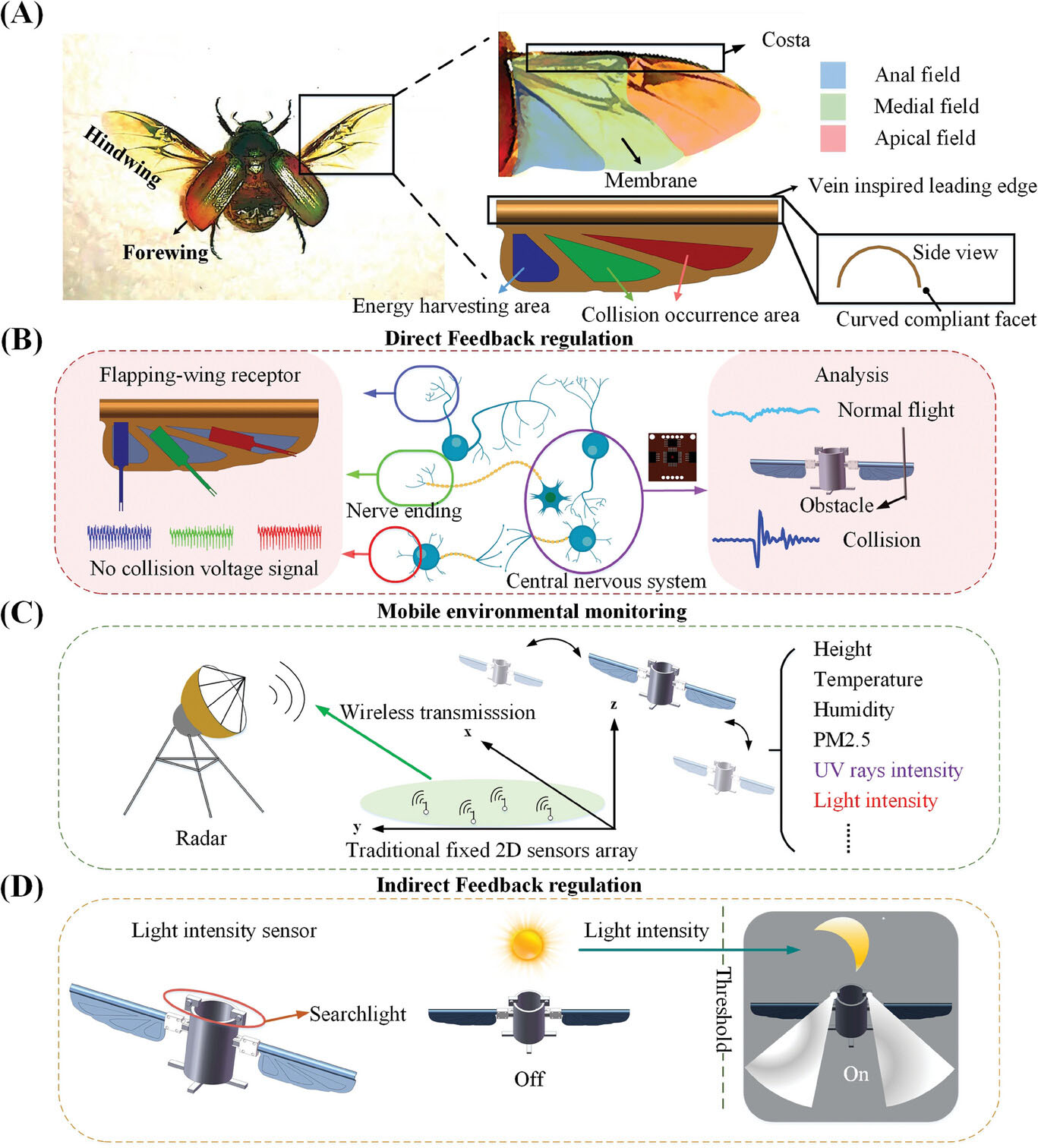| Nov 29, 2023 | |
Beetle-mimicking flapping smart wings overcome key barriers in insect-scale drones |
|
| (Nanowerk News) Engineers have long sought to unlock the secrets behind insects' uncanny flight abilities and agility in hopes of creating a new class of tiny yet capable flying robots. These flapping-wing micro air vehicles (FWMAVs) hold tremendous promise for search-and-rescue, reconnaissance, and environmental monitoring applications where small size and high maneuverability are paramount. Yet despite ongoing efforts, FWMAV development has been severely hindered by challenges integrating the demanding capabilities of aerodynamics, onboard sensing, and power supply within an ultracompact form factor. | |
| Conventional FWMAV designs rely on an array of bulky cameras and sensors to orient and control flight, hampering miniaturization. At the same time, the extreme energy demands of flapping-wing propulsion restrict feasible mission scope. | |
| Now, research recently published in Advanced Functional Materials ("Scarab Beetle-Inspired Embodied-Energy Membranous-Wing Robot with Flapping-Collision Piezo-Mechanoreception and Mobile Environmental Monitoring") demonstrates an ingenious bioinspired approach that overcomes these limitations, potentially paving the way for a new generation of highly advanced FWMAVs. | |
 |
|
| Biomimetic designs of the flapping wing and potential applications. A) Schematic diagram of bionic flapping-wing structure design, whose bionic object is beetle. The film positions in the fabricated bionic wing correspond to three fields of the beetle’s wings respectively. B) Direct feedback regulation of the aircraft based on the flapping-wing receptor. The energy harvested during flapping is used to supply energy for airborne sensors, so as to realize C) mobile environmental monitoring and D) indirect feedback regulation of aircraft. (Reprinted with permission by Wiley-VCH Verlag) | |
| “In the past, it’s been difficult to simultaneously achieve good aerodynamics, sensory capabilities, and power supply in a very small flapping-wing aircraft,” said lead author Dr. Zhimiao Yan, Professor of Mechanics at Shanghai Jiao Tong University. “We addressed this by creating piezoelectric flapping wings that multitask—harvesting energy to enable onboard sensors while also directly sensing wing motions and collisions.” | |
| This breakthrough builds on recent research into smart wing materials that exploit electromechanical coupling to extract information about wing deformations during flight. However, prior piezoelectric FWMAV wings lacked critical robustness and used simplified geometries ill-suited to aerodynamic demands. | |
| Yan’s group studied hindwing morphology, veins, and motion in beetles to bioimitate natural flapping wings with authentic geometries. Their fabrication process uses precisely layered polymers to recreate the compliance and anisotropy enabling passive twist changes in insect wings. This grants their bionic wings the lift generation, angle of attack adjustments, and bend-and-return collision resilience exhibited by their natural counterparts. | |
| Piezoelectric sensing films feature extensive partitioning across wing membrane fields, providing a distributed network of receptors without compromising aerodynamic performance. Notably, lift testing reveals these films have negligible impact even with readout wiring attached. The films serve a dual purpose—harvesting flapping energy while also transducing precise voltage signals encoding wing motions and collisions for in-flight feedback. | |
| “Our wings can sense their own speed, deformation, and collisions, much like insects’ natural sensory bristles and veins do,” said Dr. Yan. “By directly integrating sensing with the flapping wings rather than relying solely on cameras and accelerometers, we can reduce aircraft weight and complexity substantially.” | |
| This light-weight simplicity enabled successful demonstration on a real 18.2-gram flapping-wing vehicle. The bioinspired wings allowed sustained flights and acrobatic flipping maneuvers while harvesting enough power from their flapping motion to continuously run onboard UV and light sensors. | |
| “Our flapping wings serve as energy harvesters and flight receptors simultaneously, illustrating a wider ‘embodied energy’ concept we feel will revolutionize future mobile robotics,” said Dr. Yan. “This mirrors natural multifunction—for example, muscles that facilitate motion while also containing sensing nerves.” | |
| This foundational study establishes membranous piezoelectric sensing wings as a disruptive technology poised to overcome key barriers in FWMAV development. Work remains to further improve the manufacturing consistency and ruggedness for longer operational lifespans. Nonetheless, these intelligent wings presage integrated, perceptive FWMAVs that sail past prior performance thresholds. | |
| “We feel these bioinspired advances represent a watershed, bringing the long-sought goal of fully autonomous, agile, insect-scale aircraft nearer to reality,” concluded Dr. Yan. “Our intelligent piezoelectric sensing wings provide a missing pillar to enable self-contained flight control. This has profound implications for enabling robotic environmental sampling, search-and-rescue, and remote exploration at very small scales.” |
| Source: Nanowerk (Note: Content may be edited for style and length) |
We curated a list with the (what we think) 10 best robotics and AI podcasts – check them out!
Also check out our Smartworlder section with articles on smart tech, AI and more.

